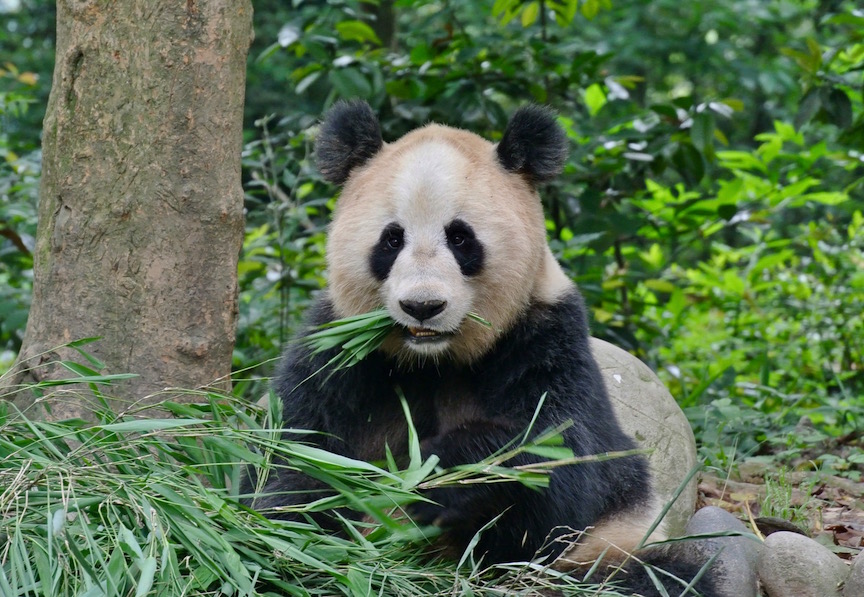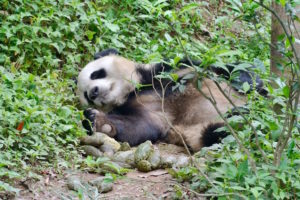Our first week at Bifengxia has been filled with panda observations, training in the behavioral studies, and meeting the CCRCGP staff. One of the first things you notice about the pandas is the amount of time spent eating—and the amount of feces that surround them.
As giant pandas are members of the bear family, they retain the digestive system of a carnivore. This means they have neither a ruminant stomach (multi-chambered like a cow) nor the gut microbiome needed to digest plant matter effectively. However, a wild panda’s diet is 99% bamboo with the remaining percent consisting of other plants and small mammals.
So what do they do? They eat A LOT of bamboo.
Bamboo doesn’t have a high nutritional content to begin with, so in combination with a poorly-adapted digestive system, how do pandas meet their energy needs? They generally eat ~25-50 lbs of bamboo each day. At Bifengxia, pandas are offered 50-100 lbs of bamboo daily brought in by the truckload. The bamboo diet includes several species and varying parts of the bamboo (leaves, hard culm, tender new shoots, etc.). They supplement this with panda bread, carrots, and the occasional apple – but it seems to me they enjoy the new shoots the most!
Giant pandas spend 10-16 hours eating or foraging for food throughout the day. This means we spend a lot of time watching them eat. During this adorable, messy, and lengthy process, we immediately noticed their forepaws were different than other carnivorous bears. Although pandas do not have an evolutionary adaptation for digesting bamboo, they do have an adaptation for eating bamboo. Pandas have evolved a ‘pseudo-thumb’ perfect for manipulating bamboo. Like a second fleshy pad on the paw, the pseudo-thumb allows the panda to grasp the bamboo while stripping and crushing it with its teeth.
What do giant pandas do when they aren’t eating?
Another large portion of their day is spent resting. Though sleeping habits likely vary between captivity and the wild, pandas sleep an average of 10 hours a day. With the amount of bamboo that pandas eat, you can imagine they defecate quite a bit, too. Interestingly, a giant panda can continue to defecate even while resting. This means you can estimate how long they’ve been resting based on the amount of feces right beside them. 5-10 boluses accompany short rests of <2 hours and 11-25 boluses often accompany longer rests of >2 hours. The panda in the above photo has probably been snoozing for about two hours!
______________________________________________________
 Hi everyone. I’m Katherine Brantley and if you enjoyed my post, please leave a comment below. If you have any questions, I’d really like to hear them. Thanks for reading. PDXWildlife is a 501 (c) (3) non-profit.
Hi everyone. I’m Katherine Brantley and if you enjoyed my post, please leave a comment below. If you have any questions, I’d really like to hear them. Thanks for reading. PDXWildlife is a 501 (c) (3) non-profit.




Thank you, Katherine, for that unique panda napping length gauge!
Those of us who watch and love Bei Bei on the Smithsonian Nat’l Zoo panda cam are thrilled to see his “sleep-time gauges” after his problem with an obstructed bowel last November. Panda poo rocks!
We on Facebook in the Mei Xiang’s Miracles group often remark at how they can sleep and poop at the same time! Nothing is sacred in the Panda World! I agree with Frances – you gave us a unique perspective, Katherine! Please keep u the great posts!
Sincerely, JoAnn